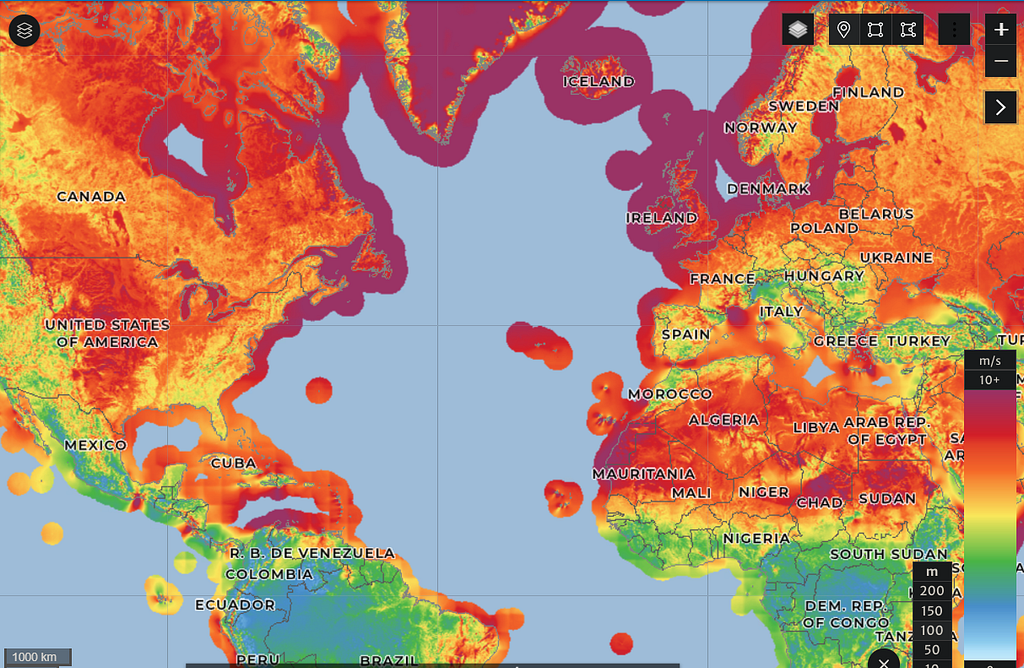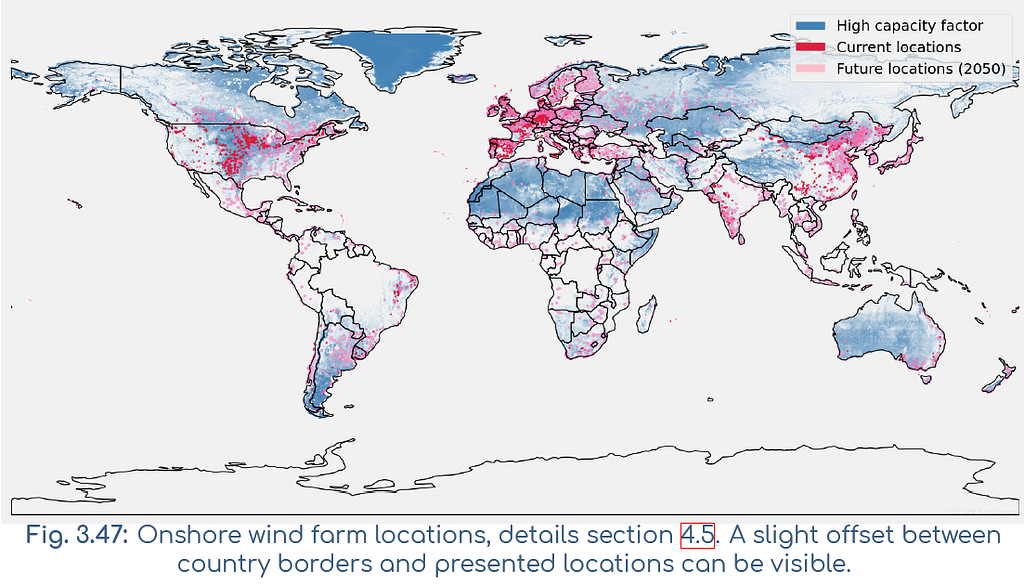How I assessed the global potential of wind energy

This article is part of a series on the DEC Report. The DEC report is a 200+ pages freely accessible report I wrote on climate change and energy. It assesses the world’s potential to tackle climate change by removing GHG emissions in energy and agriculture, and it assesses how we can optimize this transition.
- ➡️➡️ The DEC Report (pdf)
- 🌊 Hydropower potential (1/8)
- ☀️ Solar potential (2/8)
- 🌬️ Wind potential (3/8)
- 🏭 Nuclear potential (4/8)
- 🛢 How much fossil fuel do we consume each year? (5/8)
- 🔥 Energy, EROI and limits to growth (6/8)
- ☢️ How many people died because of the Chernobyl disaster? (7/8)
- ⚡ Why do we close nuclear reactors? (8/8)
Global wind power potential
Global wind power potential mainly refers to how much electricity we can produce from wind turbines. Wind turbines are a low-carbon source of energy (https://www.ipcc.ch/site/assets/uploads/2018/02/ipcc_wg3_ar5_annex-iii.pdf, A.III.2: median of ~11 gCO2eq/kWh vs > 400 for gas and > 800 for coal).
Wind turbines are currently the TOP 3 source of low carbon electricity in the world. It comes after hydroelectricity and nuclear energy, which themselves produce less electricity than coal and natural gas.

As you can see, wind electricity production has continuously increased during the last years and is currently on a kind of exponential curve. However, it is to be considered that wind turbines we currently install have a low lifespan of approximately 20 years. That is, when we have a +200 TWh increase one year, we may have a -200 TWh decrease in 20 years, making this exponential probably short term as current increases aren’t affected by a large decrease (we weren’t installing as much wind turbines 20 years ago). In order to tackle climate change and reduce energy issues, it is extremely interesting to assess the full potential of this energy in the world.
In order to do so, I used the Global Wind Atlas (GWA).

The Global Wind Atlas is a freely accessible dataset to estimate the potential of wind turbines over the world.
What it does:
- Estimate the wind speed and W/m² for a specific location on the planet
What it doesn’t do:
- Consider where wind turbines could realistically be installed
- Consider that wind turbines will produce less electricity with continous degradation
- Consider where wind turbines are currently installed, where future wind turbines will be installed, and how we can replace current wind turbines when they reach their end of life where they’re installed with newer wind turbines
In order to adjust the results from GWA, I evaluate the true capacity factors wind turbines had in some places thanks to WRI’s power plants dataset and data from EIA. I also used data on topography and population distribution around the world.
I estimate a global potential of 650 PWh/y for onshore wind turbines just with constraints on land (no forests, no crops, above a population density limit). Just land surface is therefore not a constraint for wind turbines. I didn’t estimate the potential for offshore wind turbines, based on numbers for onshore wind turbines it seems that offshore wind turbines won’t be limited by surface but rather by how fast we can install them and how much energy we need to maintain this system.
In the report I optimized the location of wind turbines based on where needs are located (i.e. where current energy production is located), but I only did this per country. A global optimization should ignore borders.
This is where the model installed wind turbines for the configuration used in the report:

As you can see there may be a large theoretical potential in some places, with a high capacity factor, but because not enough people actually live in these places, it’s harder to forecast a large installation of wind turbines there.
The main forecasted constraint on wind turbines seems to be their lifespan. We’re currently installing approximately 100 GW of wind turbines per year. In the model we can reach up to 250 GW per year:

However, as you can see, at some point in the future, wind turbines we’re currently installing will reach the end of their life (negative -250 GW). It’ll be a very large challenge to produce enough wind turbines to keep replacing these old wind turbines. While, in theory, we would have much less fossil fuel available. The current production of wind turbines largely profits from the highly CO2-intensive world we’re currently living in.
The model also doesn’t consider grid constraint, it could be extremely hard to make an efficient grid with a lot of wind turbines at it would require large quantities of copper and a large workforce to install enough cables, or it would also require a lot of lithium to build enough batteries. Pumped-storage hydroelectricity is promising but has limits and can’t be done everywhere, while hydrogen also has many limits and isn’t efficient. More constraints also exist on offshore wind turbines, while these turbines have a higher capacity factor, they’re much more complex to install and need more cement and longer cables.
Overall, in this configuration of the DEC model, I don’t expect countries to install enough turbines to produce much more than 12 PWh of electricity, and I expect that it’ll be a peak rather than a continous increase as a lot of wind turbines will reach their end of life and be hard to replace. 12 PWh alone is insufficient to replace the > 100 PWh of fossil energy we’re currently consuming. But it could be enough to replace a significant portion of fossils we use for electricity (~15 PWh of coal+gas). Yet, where we consume a lot of coal and gas for electricity, there isn’t necessarily enough land to install enoug wind turbines while using this land for carbon storage (aka forests) or food production. The electricity from wind turbines could also be used to replace parts of the oil we use in cars, by using electric cars.

Results

It seems plausible that small countries with a lot of wind could produce enough electricity from wind turbines to be autonomous IF they are able to store this energy and to re-use it to maintain this system (to continue to install enough wind turbines). Otherwise, countries should rather install wind turbines if they fit in a global strategy to entirely remove fossil fuels, and they should avoid a strategy where fossil fuels would be kept forever (i.e. in a long-term gas/wind or coal/wind strategy).
Links
You can see how some of these results were used in much more details in the DEC report. Some of the data and models I used are also available on Github.
👏 if you liked this article and I’ll do more!